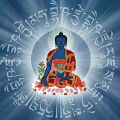Welcome home! Please contact lincoln@icrontic.com if you have any difficulty logging in or using the site. New registrations must be manually approved which may take several days. Can't log in? Try clearing your browser's cookies.
The Origins of Oṃ Maṇipadme Hūṃ: A Study of the Kāraṇḍavyūha Sūtra
 Sile
Veteran
Sile
Veteran
Fascinating-looking book by Alexander Studholme!
Summary:
Om Manipadme Hum, perhaps the most well-known of all Buddhist mantras, lies at the heart of the Tibetan system and is cherished by both layman and lama alike. This book documents the origins of the mantra, presents a new interpretation of its meaning, and includes a detailed, annotated precis of the Karandavyuha Sutra, opening up this important Mahayana Buddhist work to a wider audience.
The Karandavyuha - the earliest textual source for Om Manipadme Hum - describes both the compassionate activity of Avalokitesvara, the bodhisattva whose power the mantra invokes, and the mythical tale of the search for and discovery of the mantra. Through a detailed analysis of this sutra, Studholme explores the historical and doctrinal forces behind the appearance of Om Manipadme Hum in India at around the middle of the first millennium C.E.

Summary:
Om Manipadme Hum, perhaps the most well-known of all Buddhist mantras, lies at the heart of the Tibetan system and is cherished by both layman and lama alike. This book documents the origins of the mantra, presents a new interpretation of its meaning, and includes a detailed, annotated precis of the Karandavyuha Sutra, opening up this important Mahayana Buddhist work to a wider audience.
The Karandavyuha - the earliest textual source for Om Manipadme Hum - describes both the compassionate activity of Avalokitesvara, the bodhisattva whose power the mantra invokes, and the mythical tale of the search for and discovery of the mantra. Through a detailed analysis of this sutra, Studholme explores the historical and doctrinal forces behind the appearance of Om Manipadme Hum in India at around the middle of the first millennium C.E.

1


Comments
"There are two separate and quite distinct versions of the Kāraṇḍavyūha Sūtra....The earliest existent copies of the prose Kāraṇḍavyūha Sūtra belong to the collection of Buddhist texts unearthed, during the 1940s, in a stūpa, situated three miles outside the town of Gilgit in northern Kashmir."
The Kargah Buddha, 14km outside of Gilgit
According to the author, the text was written in a type of script which became obsolete in 630 C.E.; he and others place the likely date of composition for the prose version somewhere between the 4th and 5th centuries.
"No critical edition has been made of either the prose or of the verse version of the Sanskrit text...there exists no published translation of the sūtra in any modern European language." (Studholme, 2002)
I wonder if this has changed! How interesting that the work of origin for one of the most famous of all Buddhist mantras hasn't been fully worked with yet.
That's one thing I love so much about Buddhism - flexible gods